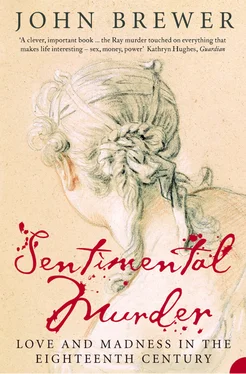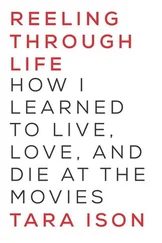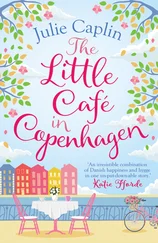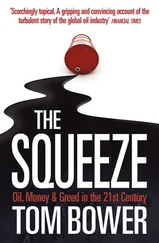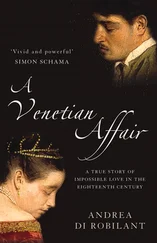But even the opposition papers were willing to acknowledge Sandwich’s dignity in his suffering. Several articles emphasized his benevolence towards Martha Ray – his willingness to pay for her education and to provide for their offspring. His performance as a good father and spouse matched the domestic virtues of his murdered lover. Others praised his remarkable action in being willing to forgive James Hackman for his terrible crime. ‘We are assured from respectable authority, that a noble Lord, much interested in the death of the late unfortunate Miss Ray, pitying the fate of the unhappy Hackman, sent a message to him after condemnation by the Honourable Captain W––– [Walsingham], informing him, “that he would endeavour to get him a pardon;” but that unhappy man replied, “he wished not to live, but to expatiate his offence, if possible, by his death 100 ”.’
Above all, reports of Sandwich’s suffering at the news of Ray’s death made the man who was regularly depicted in the opposition press as a political monster appear altogether more vulnerable and human. He was ‘inconsolable’…‘he wrung his hands and cried, exclaiming – “I could have borne anything but this; but this unmans me 102 ”.’ The General Advertiser suggested that Sandwich was so stricken that his servants feared that he might kill himself, while the Gazetteer depicted his situation as ‘deplorable’ and portrayed him as withdrawn and wounded, seeing ‘no one but his dearest friends 103 ’. The St James’s Chronicle , no special admirer of Sandwich as a politician, summarized the prevailing sentiment:
From [Ray’s] having lived so long with his Lordship, there is no Doubt but his feelings on this Occasion must be such as the most lively Grief can inspire. Indeed, we are told, that his Lordship’s Sensations expressed the greatest Agonies; and that whatever may be his sentiments on political Matters, in this affair he has shown a Tenderness which does the highest Credit to his Heart, and the warmth of his Friendship 104 .
Thus all three of the main parties were victims, united in their common suffering. Ray and Hackman excited the most sympathy, because they both lost their lives, but even Sandwich was given his share. The press portrayed them all as suffering from forces beyond their control and for which they bore little or no responsibility. Hackman was driven to his crime by feelings that overpowered him; Ray was unable to escape his unwanted attentions; and Sandwich was suddenly and unexpectedly deprived of the woman he loved deeply. So the early newspaper reporting, strongly informed by the friends of Sandwich and Hackman, was remarkably free from acrimony and blame; it invited readers to sympathize with the victims, to understand their plight and, more generally, to interpret the sad events as a consequence of natural desires and feelings, ‘the common passions of Humanity 105 ’. As PHILANTHROPIST put it in the St James’s Chronicle , ‘let us endeavor therefore to trace this rash and desperate Action, from some cause in human Nature equal to the Phaenomenon 106 ’.
Though the majority of newspaper reports encouraged readers’ sympathy, a few were overtly censorious. Several news commentators (as well as writers of unpublished, anonymous letters to Sandwich) interpreted Ray’s death as the result of the Earl’s profligate and immoral life, and urged him to see the error of his ways and to reform. In the days just before Hackman’s trial the London Evening Post 101 – an old enemy of Sandwich’s – published a number of items attacking the Earl. These included a long letter upbraiding the public for extending too much sympathy to Ray, Hackman and Sandwich and blaming the murder on the moral failings of all three of them. ‘The public’, it began, ‘at present give way to a strange kind of sympathy, whilst they shed tears of condolence with one of the vilest of men, to alleviate his distresses for the loss of his mistress 107 .’ What about the victims of the American war, it asked its readers, people who had suffered because of the benighted political policies of Sandwich and his colleagues? Should we not be more concerned about ‘the many thousand widows and orphans, who rend the continent of America with piercing lamentations for the loss of their husbands and fathers who were murdered in cold blood, or slaughtered in the field by the emissaries of despotism 108 ’? After damning Sandwich as a ‘man who, by his voice and counsel, had drenched whole provinces with murdered blood 109 ’, the author turned to Martha Ray. Unfortunate as she was, ‘we should not forget what she was; we should not lament her as a spotless, or amiable character, but as a deluded woman cut off in the midst of her days, without any previous warning 110 ’. Her fate should not obscure the moral lesson of her life: ‘We should rather point out the impropriety and wickedness of such connections as she formed, which, through a variety of complicated circumstances, laid the foundation of her untimely death, and which frequently, almost always, in one way or another, terminate fatally.’ ‘Had Miss R – been virtuous’, the writer concluded, ‘she had not fallen as she did 111 .’ Similarly, Hackman’s fate was explained by his moral failings: ‘had the wretched assassin cultivated that delicacy of sentiment which abhors impurity, and suffered no criminal passions to influence his conduct, he would never have found himself within the walls of Newgate, and might have attained an honourable old age, and gone down to the grave in peace 112 ’.
But, on the whole, it was unusual for the three protagonists to be portrayed as so morally reprobate. Hackman was repeatedly characterized as ‘unfortunate 113 ’ and as having ‘delicacy of sentiment 114 ’, a quality he shared with Ray; even Sandwich was complimented for his tenderness. The press reporting of the case was designed to elicit sympathy not censoriousness. No doubt, as I have explained, this was partly because Sandwich’s and Hackman’s friends worked hard to shape the newspapers’ response to the case. But it is worth asking why this was possible, and why there was so little attempt to offer an alternative version of the events of the spring of 1779. Why, to put it in modern terms, was Sandwich and Hackman’s spin on the murder and its aftermath so successful?
The love triangle of Ray, Hackman and Sandwich was shaped as a sentimental story, designed to reveal the feelings of the protagonists and to excite the feelings of readers. Reporting and commentary were less concerned with what had happened, though trying to establish the facts of the case was important, than about a mystery of the human heart, an effort to understand the motives and feelings of those involved. Did Ray really love Hackman? Was Hackman justified in feeling that Ray had led him on with false promises, or was he suffering from a sort of delusion, what contemporaries called ‘love’s madness’? Similarly, the aftermath of the crime was described indirectly through the feelings of Lord Sandwich, of Hackman and, perhaps most prominently, of the public. The responses to the bloody murder, affecting trial and the murderer’s execution were covered as extensively as the crime itself. The newspapers pulled readers into a wide circle of sympathy. The press largely avoided the blood-and-gore variety of crime reporting, which had hitherto been common. Its accounts were neither sensational nor melodramatic. Readers were made to understand events through the emotive responses of participants by a form of indirect narration. They were invited to share in the distresses of the victims, to express their sympathy, to establish an emotional closeness rather than a moral distance.
This sort of complicity has to be understood in the light of prevailing ideas about human sympathy and sensibility. Eighteenth-century human sciences, which embraced physiology, psychology, sociability and morality, had created a new way of looking at, depicting and judging human conduct which was less concerned with its strict conformity to a universal moral law than with its social and psychological complexity. We cannot understand the story of Hackman and Ray unless we take some time to explore the values and ways of seeing that informed how contemporaries understood those events.
Читать дальше
